 |
C. aponogetifolia and C. affinis
growing in a small aquarium at A.J.Huurman. Moderate temperature (ca 20 °C, no heating).
Both species prefer hard water (calcareous). The tank is filled with only a few cm gravel.
Fish excrements provides the plant nutriments. This tank stands for years and was to be
cleaned some time. Heaters were already removed. The tube in the middle on the surface is
not for air bubbles but is part of the inflorescence of C. aponogetifolia. A great
surprise. |
Temperature around 25 °C, light about 12 hours. The use of CO2 is not
necessary. There are many don'ts and a few dos. Most Crypts don't flower when submerged
but some do.
There are even records on cultivating Crypts in garden ponds in moderate climates.
Emerged
For the emerged culture there are many possibilities. Choose one of
these techniques to get your plants to flower.
Like the submerged culture, one can lower the water level to a few cm, enabling the plants
to get their leaves into the air.
This way is mostly seen in botanical gardens: plants in the basins are just below water
level. This 'semi-emerged' culture is quite stable but requests a lot of room.
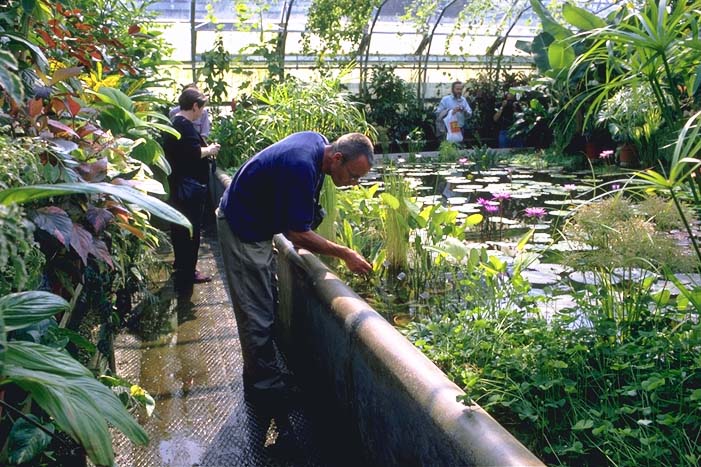 |
The author in Oxford Bot.Garden (UK). Most
botanical gardens hardly have a collection of Cryptocoryne. As they have one, they are
often not well labeled. |
An efficient way is to put the plants in pots of ca 5-10 cm and place
them in an empty fish tank or specially built container. Moistened peat litter between the
pots provides a good climate, the tanks closed with a glass cover. Another way is to
circulate water around the pots, especially efficient when cascading a couple of tanks.
The culture in pots is practical for taking pictures and prevents runners from walking
around.
 |
Niels Jacobsen in the (not public) hothouse of
the Botanical Garden of Copenhagen (1985). Plants are potted and stand in a few cm slowly
running water. Note the HQL bulbs for additional lighting in winter. The table is covered
by a plastic sheet to keep humidity near to a 100%. |
A variant on the semi-emerged culture which has proved
itself is to use plastic crates, the ones to put in children's toys for example, filled
with soil just flooded with water.
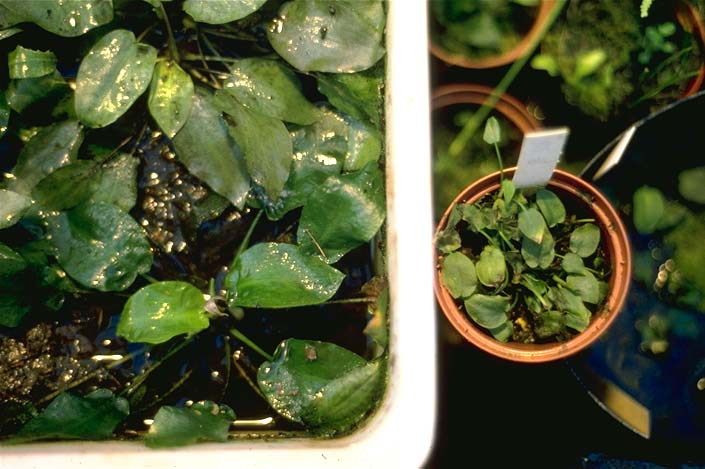 |
At left, C. elliptica is growing in a plastic
crate filled with pure beech tree soil (top view). At right the same species potted (10 cm
size) in a granite soil mixture under the same conditions (at Copenhagen). This most
luxurious growth is also reported for other species, for example C. pallidinervia.
photo Jacobsen |
Soil
Washed sand mixed with peat litter (50/50% volume) is an excellent
medium to cultivate Crypts. Most species will grow in it. For there is any nutriment in
it, you can add some clay and/or you have to spray your plants every week with a normal
indoor plant fertilizer.
You can use forest soil from the beech tree (Fagus sp.) to replace the peat
litter or to mix it with. You can even use pure beech tree soil for species from Borneo
which are difficult to grow, mixed , if any, with some clay powder. Be aware that beech
tree soil is extremely acid. The pH in your tanks can go below 4, dissolving metals and
even some plastics.
Good results are made with meranti chips instead of peat litter. Pure clay proves to be
difficult.
Light
Growing Crypts outdoors in a greenhouse is very nice though you will
have to shade most Crypts because of the light.
Indoors, the plants can be illuminated with fluorescent tubes. The colour of the light does
not matter very much. Two or three fluorescent tubes over your tank for 12 hours daily
will make most species flower. Some species will not flower in these conditions because
they need more light, e.g. C. crispatula.
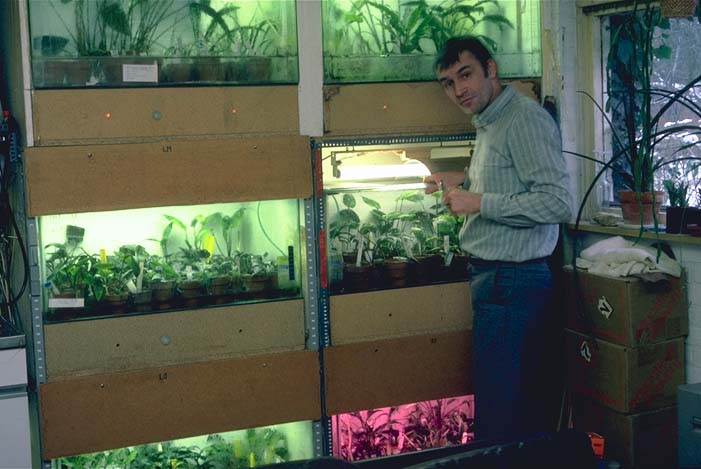 |
The collection of the author around 1985. The
tanks are about 60x80 cm, demanding together one square meter floor. The tanks are
standing on a box which is heated by bulbs (see below). Later a flow system is build,
heated water cascading through the tanks, and the heating boxes were eliminated.
Illuminating is done with several types of fluorescent tubes. The most cheap will do as
well as the special ones, but you will have to accept the poor colour quality.
|
Temperature
The best temperature for cultivating Crypts is around 25 °C. Many
species grow well at 20 °C. In an outdoor greenhouse the temperature may cause risks in
summer. Temperatures over 40 °C are disastrous for most species, but the common Sri Lanka
species (C. wendtii, C. beckettii) will probably survive. A short period
on 0 °C is no problem for most species. C. diderici survived one week at minus
10 °C.
A very easy and reliable technique to keep your plants at the right temperature is putting
a box under your tank equipped with two bulbs is series. 2 Bulbs of 40 or 60 W in series
keeps your tanks about 5 °C above room temperature. Lifetime far over 10 years!
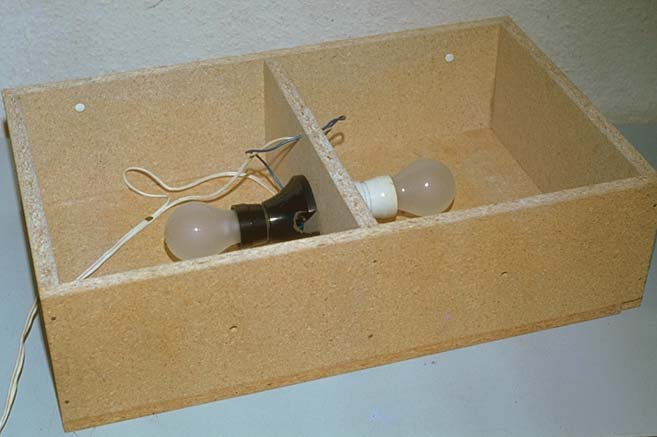 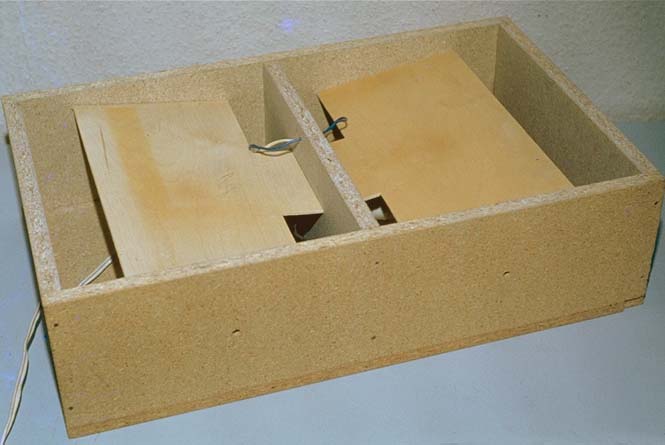 
Two identical bulbs in series provide a heat flow in the
box under your tank.Call an expert for the wiring.
Fertilisation
If you don't use clay or beech tree soil, you will have to use a
fertilizer. A common household fertilizer for indoor plants is suitable. Choose the ones
appropriate for hydro culture. Spray the leaves every week and put some solution in the
pots. Take half of the concentration that is mentioned on the instruction label.
Diseases
The well known Cryptocoryne disease in aquaria is probably caused
by too high a concentration of nitrate. Just change your water regular; every week one
quarter as usual in fish keeping.
In emerged culture, many problems may arise. Most problems can be avoided by taking away
infected parts and putting the plants not too close to each other. Regularly cleaning up
the pots and the surface layer is effective to prevent problems.
Insects can be killed by normal household aerosol sprays. Fungus may be controlled by Baycor
from Bayer. Always try first on one or a few plants and wait one week before applying it
to the whole collection. Several people lost their whole collection by being too fast.
Micro propagation
Micro propagation is a quick method for propagation. Even hobbyists have a lot of
experience with it. Look for special articles on this topic. A point of special interest
is to set up a gene bank and, when established, these technique offers a very stable
environment.
 |
Already in 1976, Dutch aquarists experimented with tissue cultures.The
Agricultural University Wageningen (NL) started to set up a gene bank on Cryptocoryne, but
when budgets went down the project was skipped. Commercial growers are not interested in
keeping species which are difficult to grow in their laboratories because there is no
market for them.
|
Hormones
Gibbelerines are plant hormones that can be used to induce flowering. There are a few
reports on the use of it for Cryptocoryne, but as far as I know, results of use
for Cryptocoryne are very poor.
Entry numbers
Label your plants and give them an entry number to identify your plant and keep record of
it. Runners from one plant can hold the same number. Its essential to keep things clear,
for example to identify your photographs of your C. wendtii's.
 |
top down: labels of Möhlmann, Jacobsen and Bogner |
Potting your Crypts
All the roots of your dug out Crypts will die and will cause problems in your pots.
Shorten the roots to about a few cm, just to give the plant an anchor. Remove the older
leaves to just two or three.
Put a piece of filter tissue on the hole in the pot and fill half the pot with your soil
mixture. Press it firmly in the pot making a 'hill' for draping the roots around. Place
the plant, keep it with one hand and fill the pot. Press on the sides to fasten the plant.
Keep 1 cm free height in the pot. Finally, drip some water around the stem.
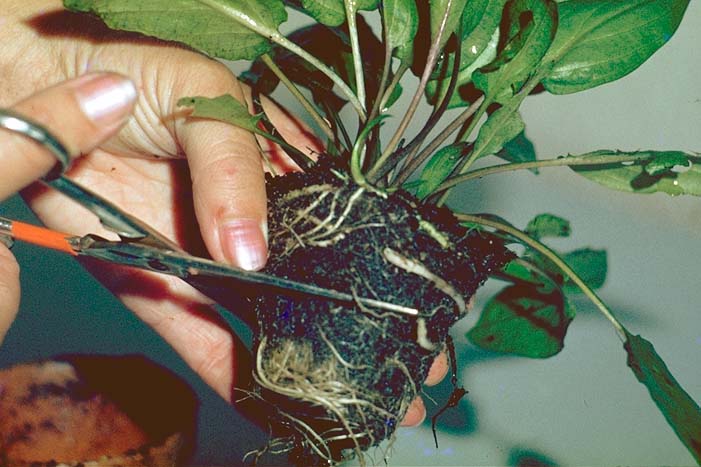 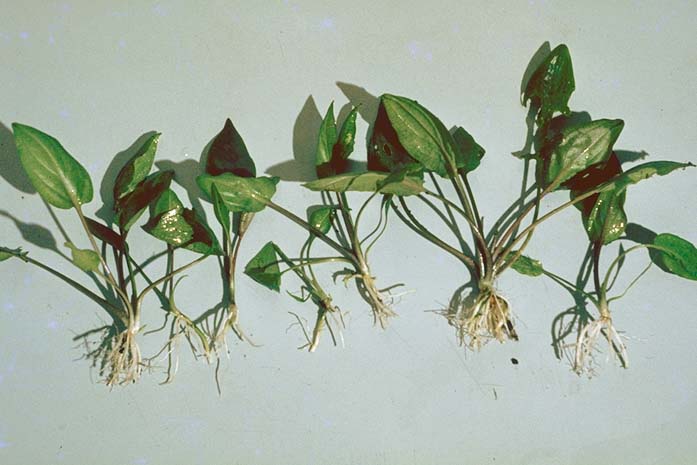 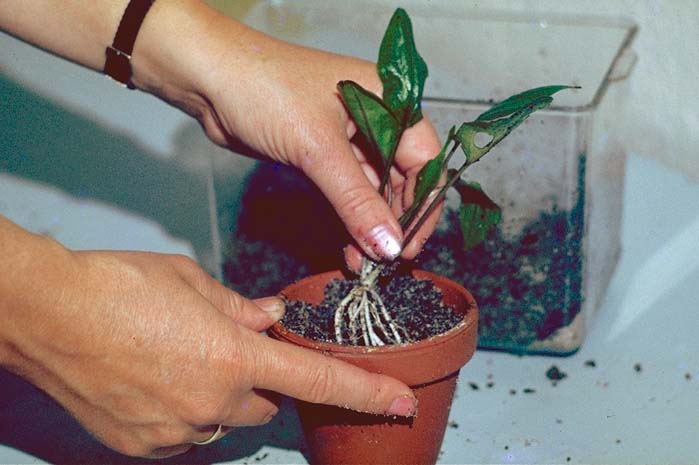
After a half to one year C. cordata var. siamensis fills the pot. For safety, keep
only two plants.
Beginners' luck
When things are going well, you might expect the first inflorescence in about three
months. Imported plants may have a hidden bud and may flower at once. It usually takes a
considerably longer time. Experiment with soil, light and so on. It is very hard to make
some species flower.
Rescuing Crypts
Perhaps the only way to rescue a 'collapsed' crypt is to put the rhizome in an 'old'
aquarium. Let the rhizome float on the surface, snails and guppies do the job for you.
With good luck, the rhizome will sprout again.
To be updated ! |